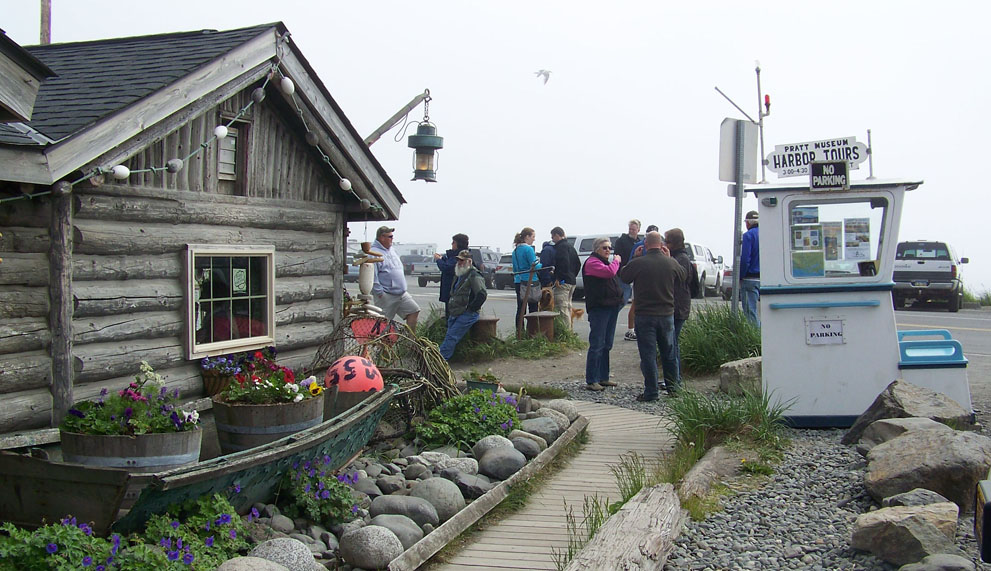With so much boat traffic in and out of the Homer Harbor, it’s easy to think the harbor is all about fishing.
Not true.
The Center for Alaskan Coastal Studies’ twice-daily Creatures of the Dock tour offers an hour with a naturalist to learn about the intertidal life existing in the harbor. The Pratt Museum’s 1.5-hour historic harbor walking tour offers a glimpse at how the Homer area, including the harbor, came to be.
The CACS tour begins at the center’s yurt near the top of Ramp 2, with participants given laminated cards to help identify life forms existing in the harbor.
Sarah Medley, one of many CACS naturalists that take turns conducting the tours, is quick on her feet, making tours fit what can be seen. For instance, before descending the ramp to the floats, she asks, “See anything?” There on the rocky beach below are orange and purple true stars and a scattering of yellow-green pop weed.
Once on the dock, Medley points out clusters of muscles attached to piling. Hard to imagine that each day, each of these tiny creatures filters more than 26 quarts of water.
Using “belly biology,” lying on one’s stomach on the dock for an up-close glimpse of what’s beneath the surface, Medley points out what looks like cauliflower: the plumose anemone, its frilly edges swaying in the harbor’s current.
Spotting a green sea urchin, she draws attention to its hair-like tube feet and its mouth, known as “Aristotle’s lantern.” What to urchins eat? Holes in a piece of kelp are evidence that urchins have been snacking.
A limpit is the next highlight of the tour. Medley describes how the nocturnal creature spends its entire life within a small circular area: plowing it, harvesting the food it finds and then fertilizing it.
Finally, Medley leads the group to a crate someone once hung in the water off one of the floats. Inside, Medley finds a mossy chiton, a gunnel fish that quickly flips its way out of sight, anemones of varying sizes and “sea pork” or colonial tunicate, orange round shapes that partially covering the crates sides.
“This tour is for visitors and locals alike,” said Melanie Dufour, CACS outreach and marketing director. “(The harbor) is kind of hidden, but it’s right under our feet. It’s pretty remarkable.”
The Pratt Museum’s historic harbor walking tour gives a completely different perspective. Tours are led by Ryjil Christianson, the museum’s director of education, or Linda Rowell, a museum board member.
First stop is the Salty Dawg, one of Homer’s first structures, built in 1897.
With the harbor as a backdrop, the guide — in this case, Rowell — gives a chronological overview of the area’s residents that begins 5,000 years ago and continues to present time. Throughout her presentation, she includes entertaining stories about early settlers.
Next, Rowell focuses on the harbor’s development, where it was originally built, why it moved and the 1964 Easter weekend harbor dedication that was canceled due to the 9.2 Good Friday earthquake that wrote a new chapter in the state’s and the harbor’s history.
Then, Rowell draws attention to fishing. What’s the difference between drift, seine and halibut boats? What are fishing quotas? How do local boat designers build vessels fit for these waters?
The last stop is Coal Point Trading Company, where Rowell describes the steps of shipping processed fish and ensuring it gets to the sport fishermen who caught it. At the peak of the season Coal Point ships 12,000 pounds of fish a day, guaranteeing overnight delivery.
For Rowell, the size of the tour group can be challenging — keeping track of everyone and making sure she’s heard — but her knowleldge and entertaining stories ensure that Homer’s history comes alive with stories about people, not just facts and figures.
McKibben Jackinsky can be reached at mckibben.jackinsky@homernews.com.


